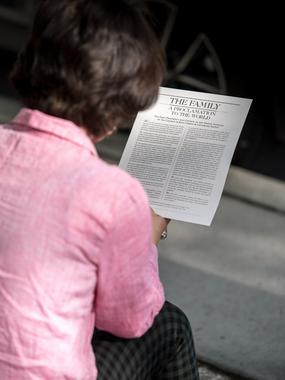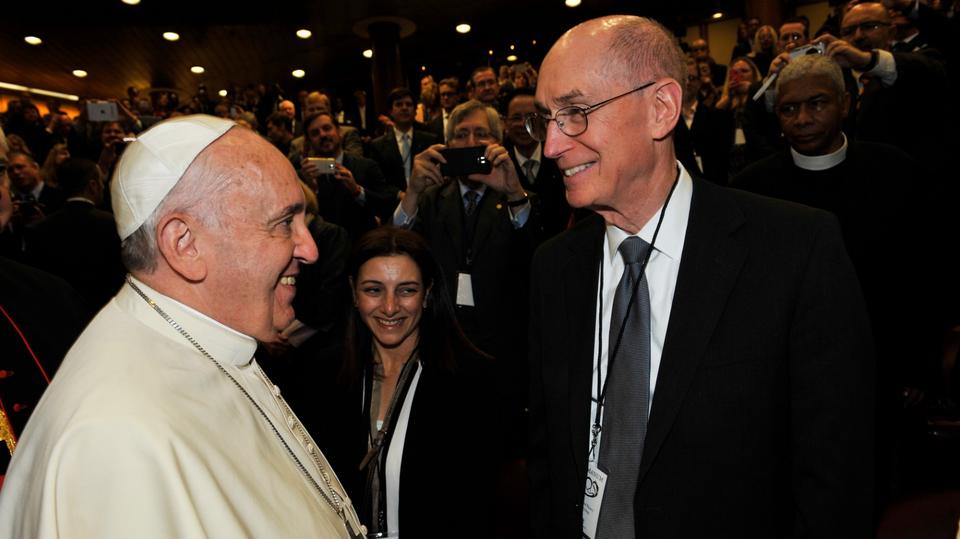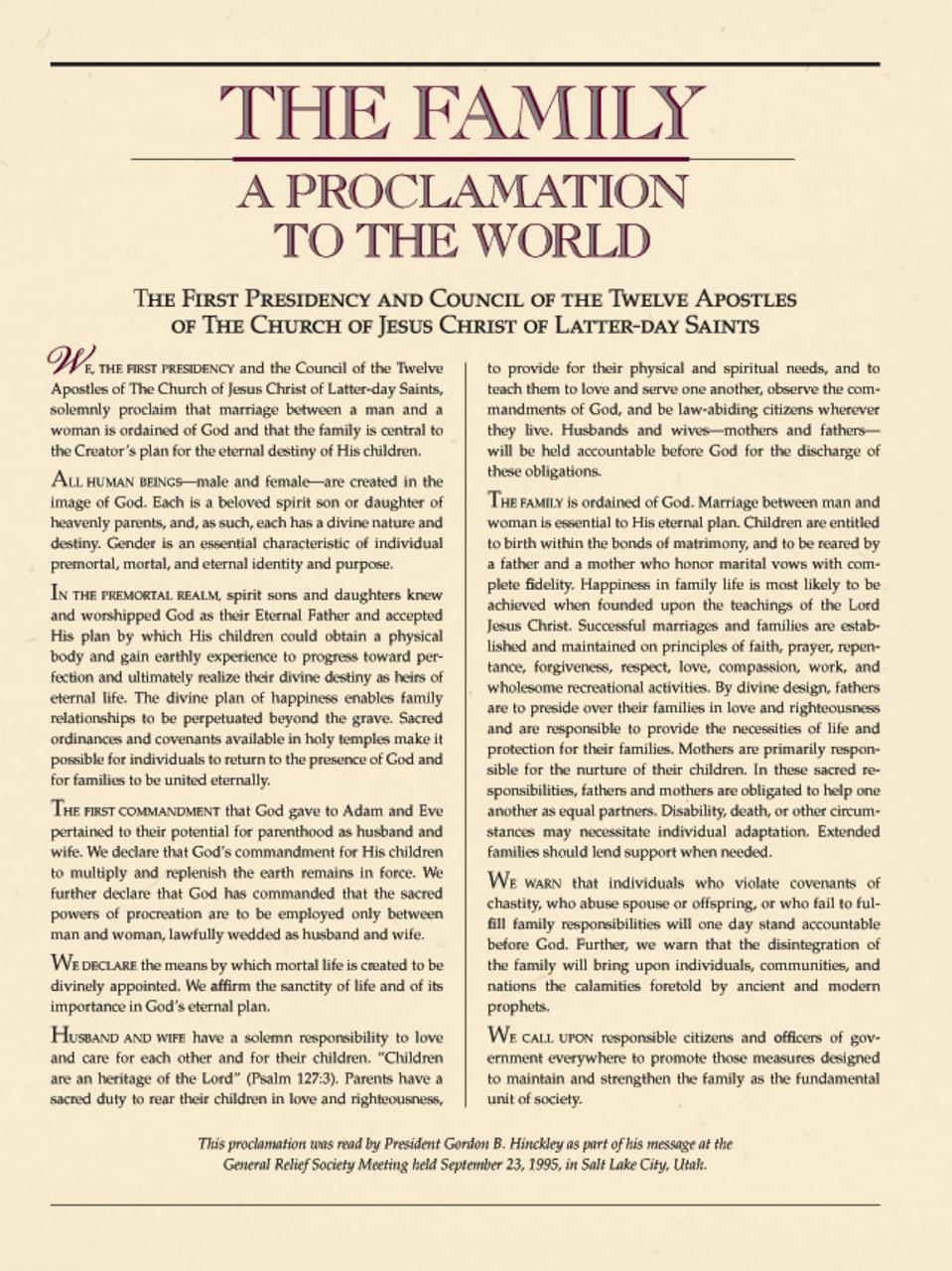
Family proclamation
A family kneels in prayer.2020 by Intellectual Reserve, Inc. All rights reserved.This story appears here courtesy of TheChurchNews.com. It is not for use by other media.
By Sydney Walker, Church News
Concluding the General Relief Society Meeting on September 23, 1995, President Gordon B. Hinckley looked into the eyes of women young and old, married and single, with and without children — “some whose burdens are so very heavy” — and thanked them for their resolution to do what is right.
In a world of turmoil, deception and shifting values, “we have felt to warn and forewarn,” he said.
The late 16th president of The Church of Jesus Christ of Latter-day Saints proceeded to introduce a proclamation declaring and reaffirming the Church’s standards, doctrines and practices relative to the family: “The Family: A Proclamation to the World” issued by the First Presidency and Quorum of the Twelve Apostles.
After reading aloud the proclamation, President Hinckley emphatically stated, “We commend to all a careful, thoughtful and prayerful reading of this proclamation. The strength of any nation is rooted within the walls of its homes. We urge our people everywhere to strengthen their families in conformity with these time-honored values” (“Stand Strong Against the Wiles of the World,” “Ensign,” Nov. 1995).
The family proclamation articulates the divine purpose of families in the plan of happiness. It makes clear that marriage between a man and a woman is ordained of God, and that all human beings are beloved spirit sons or daughters of Heavenly Parents. It teaches the sacred responsibilities of spouses and parents and the principles of successful marriage and family life.
Since President Hinckley issued the family proclamation 25 years ago, its teachings have been widely referenced by Church leaders in meeting with Latter-day Saints and in interfaith settings. Its principles have shaped research and curriculum on the family at Brigham Young University (BYU). The proclamation hangs on the wall in countless members’ homes and is shared by missionaries around the world.
Why Is the Proclamation So Significant?

Family proclamation
A woman reads "The Family: A Proclamation to the World," announced at the conclusion of the General Relief Society Meeting on September 23, 1995, by President Gordon B. Hinckley.2020 by Intellectual Reserve, Inc. All rights reserved.On the 10th anniversary of the proclamation in the October 2005 general conference, Elder M. Russell Ballard of the Quorum of the Twelve Apostles said the “prophetic document” was ahead of its time in defending traditional family values. Its clear and simple language stands in contrast to society’s confusion and convoluted definition of family.
“It was then and is now a clarion call to protect and strengthen families and a stern warning in a world where declining values and misplaced priorities threaten to destroy society by undermining its basic unit,” said the Apostle, who is now the quorum’s acting president (“What Matters Most Is What Lasts Longest,” Oct. 2005 general conference).
Since the Church was established in 1830, only six proclamations have been issued by Church leaders — the two most recent being the family proclamation and “The Restoration of the Fulness of the Gospel of Jesus Christ: A Bicentennial Proclamation to the World,” read by President Russell M. Nelson during the April 2020 general conference.
Others include the 1841 proclamation detailing the progress of the Church, the 1845 proclamation on the Restoration of the gospel, the 1865 proclamation on the nature of God, and the 1980 proclamation on the 150th anniversary of the Church’s organization. The first three proclamations were issued in the first 35 years after the Church’s organization, and the last three came in the past 40 years.
Proclamations are different from official declarations, doctrinal expositions and statements on policies. Rather than being specifically directed at Latter-day Saints, proclamations are generally directed to the world.
How Church Leaders Have Used the Family Proclamation
“The Family: A Proclamation to the World” has been cited more than 150 times in general conferences and used in interfaith discussions at the Vatican and other international stages over the past 25 years.
At the World Congress of Families held in Amsterdam, Netherlands, in August 2009, President Nelson — then a member of the Quorum of the Twelve Apostles — quoted excerpts from the proclamation to emphasize the importance of the family as the fundamental unit of society.
“On all sides, the family is under attack,” he said. “Many wonder if the institution is no longer needed. Our response is certain. If there is any hope for the future of nations, that hope resides in the family. Our children are our wealth; our children are our strength; our children are indeed our future!”
Addressing religious leaders at the Vatican in November 2014, President Henry B. Eyring of the First Presidency called for “a renaissance of happy marriages and productive families” based on the principles of the family proclamation.

Pope Francis and President Eyring at theVatican
Pope Francis greets President Henry B. Eyring in the Synod Hall at Vatican City as the colloquium on marriage begins. © Chris Warde-Jones/Humanum.it.“As we work to build and encourage faithful, loving marriages in which men and women become as one and nurture their families, the Lord will multiply our efforts,” he said. “As we join together in this work, I promise progress toward that happy result,” he said.
Speaking during a faith-based panel discussion about refugee integration at the United Nations in New York City in April 2017, Relief Society General President Jean B. Bingham expressed her hope that faith-based organizations “will all work together through small and simple means to accomplish extraordinary things.
“As defined by my faith, and by the United Nations, the family is the fundamental unit of society,” she said, drawing on the family proclamation. “Thus, care should be taken to protect the family, especially those in dire circumstances.”
Elder Jeffrey R. Holland of the Quorum of the Twelve Apostles underscored the family as the cornerstone in society as he spoke to members of the Senate and Chamber of Deputies in Argentina in May 2018.
“My friends, the family matters,” he said after introducing the family proclamation. “Indeed, a nation’s values and strengths are but the sum total of the values and strengths of its families.”
Impact at BYU — and Beyond
Alan Hawkins, director of the BYU School of Family Life, said the school feels a special responsibility to students and the Church to help the family proclamation “come alive in people’s souls and in their hearts.”
When Elder Merrill J. Bateman began his tenure as BYU president in January 1996, he asked faculty to explore ways to support and promote the family proclamation and its principles. Hawkins, who has been at BYU for 30 years, was a faculty member at the time.
One of the most visible impacts of BYU’s response Elder Bateman’s encouragement was the creation of the School of Family Life, formerly the Department of Family Science, Hawkins said.
“When Elder [Boyd K.] Packer dedicated the School of Family Life in 1998, he gave us a very direct charge, and that was to make the family proclamation our charter document,” Hawkins said.
“We take that seriously, even now, 25 years later. It’s infused in our curriculum. We talk about it regularly as we teach. And I think as researchers, we feel like the family proclamation has given us a guide of important things to focus on.”
The BYU Family Studies Center (which existed for a few decades before the creation of the School of Family Life) was refocused to enlarge the School of Family Life’s mission and charge. A course on the family proclamation and a textbook were developed. Today, students in the School of Family Life are required to take the Eternal Family class, and other students have the option to take the religious education version.
“One would think it would be difficult to take a full semester to study 609 words,” Hawkins said. “But I promise you that it is not. There are so many rich and deep topics to be covered.”
As one who taught at BYU before the proclamation was issued and has watched its impact over the last 25 years, Hawkins said, “I think there’s no question that the family proclamation has given us in the School of Family Life a greater sense of mission and purpose.”

The Family: A Proclamation to the World
The Family: A Proclamation to the World.2020 by Intellectual Reserve, Inc. All rights reserved.Copyright 2020 Deseret News Publishing Company